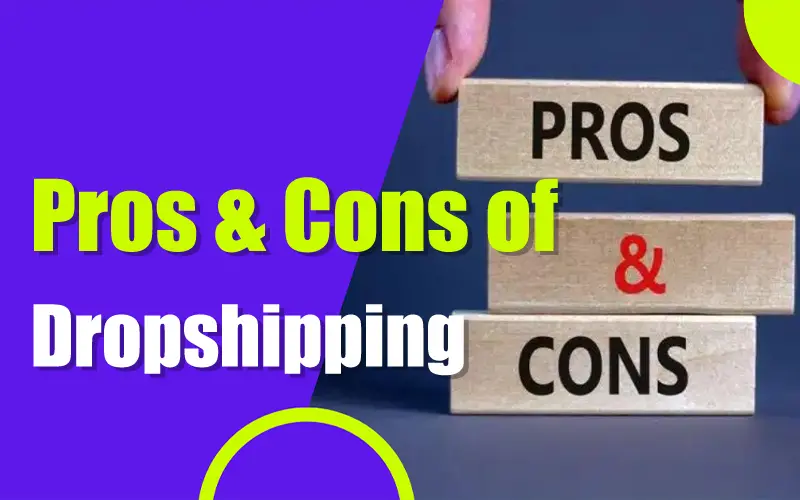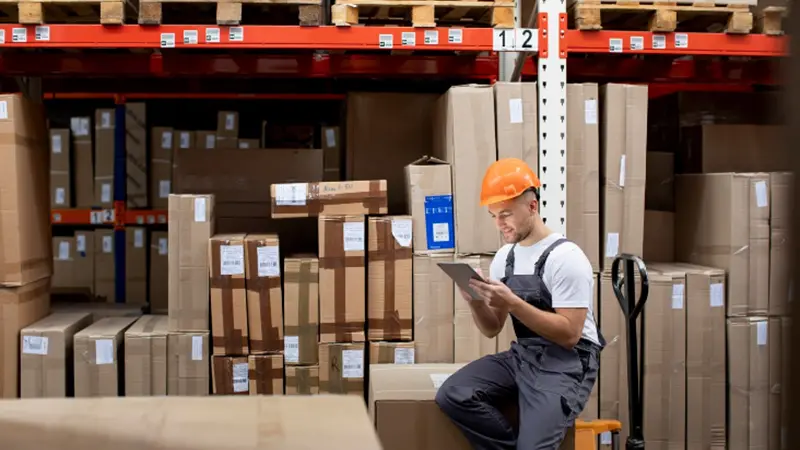The allure of launching your own online business is undeniable. You can be your own boss, set your own hours, and turn your passions into profits. But the reality of managing inventory, warehousing costs, and complex shipping logistics can quickly turn that dream into a logistical nightmare. With dropshipping, you can skip the headaches of inventory management and focus on the creative side of things.
But before you jump on the dropshipping bandwagon, make sure you weigh the pros and cons of dropshipping. This comprehensive guide will take you on a deep dive into this popular business model, exploring its exciting possibilities and potential pitfalls. Let's delve into everything from dropshipping process to dropshipping pros and cons. Get ready to discover if dropshipping is the key to unlocking your e-commerce dreams.

What Is Dropshipping?
Imagine an online store brimming with unique products, ready to be shipped to eager customers. But here's the twist: you don't hold any of that inventory yourself. In the world of dropshipping, you act as the middleman, connecting customers with products from a third-party supplier. When a customer places an order on your online store, you relay it to the supplier.
The supplier then handles all the fulfillment logistics. This eliminates the need for you to manage inventory, warehouse space, or handle physical products yourself. Dropshipping allows you to focus on building your brand, all while offering products without the upfront investment. Sounds too good to be true? Let's see this intriguing model works and explore dropshipping pros and cons.
How Does Dropshipping Work?
Dropshipping might sound complex, but the core process revolves around a streamlined flow:
- Dropshippers Build an Online Store: This is your digital storefront, where you showcase the products you'll be selling. Most entrepreneurs use ecommerce platforms like WooCommerce and Shopify to create a user-friendly website.
- Partner with Dropshipping Suppliers: Research and identify reliable suppliers in your niche. These suppliers will hold the inventory and handle dropshipping fulfillment.
- Customers Place Orders: Excited customers browse your online store, find the perfect product, and place their order.
- Auto-Sync Orders to Suppliers: Many dropshipping platforms offer automated features that seamlessly transfer customer orders to your chosen suppliers. No need for manual data entry!
- Suppliers Fulfill Orders: Once they receive your order, the dropshipping supplier springs into action. They carefully package the product and ship it directly to your customer.
- Payment Processing: You collect payment from the customer at the retail price you set. Once the order is fulfilled, you pay the supplier for the wholesale cost of the product.
- Customer Receives Products: Finally, through the complete and efficient supply chain, the happy customer receives their purchase, completing the dropshipping cycle.
Remember, you're essentially the middleman, connecting customers with products from a supplier. Your key role lies in marketing your store, managing customer service, and ensuring a smooth buying experience. Plus, analyze the pros and cons of dropshipping before embarking on this journey to make better choices.
Is Dropshipping Still Worth It In 2024?
The allure of dropshipping remains strong, fueled by the ever-expanding e-commerce landscape. According to Statista, the dropshipping market size is projected to balloon to a whopping 476.1 billion U.S. dollars by 2026. But with competition fiercer than ever and consumer expectations constantly evolving, is dropshipping still a viable option for aspiring entrepreneurs in 2024?
The answer is yes! However, your profits depend on your approach and willingness to navigate the pros and cons of dropshipping. While the low upfront costs and operational flexibility are undeniable advantages, challenges like ensuring reliable supplier performance can't be overlooked.
The Pros of Dropshipping
The world of e-commerce beckons with its vast potential, but the thought of investments and logistical nightmares can be daunting for entrepreneurs. Enter dropshipping, a business model that throws open the doors of e-commerce with surprisingly low costs. Let's delve into the enticing advantages that make dropshipping an attractive option:
1. Low Entry Barrier
Unlike traditional retail businesses, dropshipping eliminates the need for significant upfront investment in inventory. You don't have to purchase products in bulk, rent warehouse space, or worry about managing stock levels. This translates to a much lower financial risk, allowing you to launch your online store with minimal capital.
With dropshipping, your initial investment goes towards building your online store, marketing efforts, and design costs for creating unique branding elements. This significantly lower barrier to entry makes dropshipping ideal for entrepreneurs with a tight budget or testing the waters of e-commerce.
2. No Inventory Management
With dropshipping, the responsibility of storing, packaging, and shipping products falls squarely on the shoulders of your supplier. This means you are free to concentrate on the strategic aspects of running your business.
These strategies include curating a compelling product selection, crafting an engaging brand story, and implementing effective marketing campaigns to attract customers. This frees up valuable time and resources that would otherwise be consumed by the tedious tasks of inventory control.

3. Product Diversity
Imagine offering a wide variety of products without the burden of holding any physical stock. Dropshipping empowers you to boast a diverse product catalog, limited only by the selection offered by your suppliers. This allows you to cater to a broader audience and potentially tap into niche markets with unique dropshipping product offerings.
Besides, you can experiment with different product categories, test customer preferences, and adjust your selection based on market trends. This flexibility in product offerings allows you to adapt and evolve your online store as your business grows.
4. Automated Order Fulfillment
Gone are the days of manually processing orders and scrambling to fulfill them. Many dropshipping platforms offer seamless integration with your online store, enabling automated order fulfillment.
Once a customer places an order, the details are automatically transmitted to your chosen supplier. The supplier then handles picking, packing, and shipping the product directly to your customer. This automated fulfillment method streamlines your operation and frees you from the time-consuming tasks of order processing.
5. Flexibility
Dropshipping offers a level of flexibility that traditional retail businesses struggle to match. You're not tied down by a physical store location or the limitations of your inventory. You can manage your business from anywhere in the world, enjoying a greater work-life balance. This flexibility also extends to your product offerings.
Since you don't hold any inventory, it's relatively easy to update products offered at your store based on market trends or customer feedback. This adaptability allows you to quickly respond to changing consumer preferences and optimize your product selection for maximum impact.
6. Easy to Scale Business
Scaling up is a natural progression. The beauty of dropshipping lies in its inherent scalability. Since you don't manage inventory, there's no need to invest in storage spaces or hire extra staff to handle increased order fulfillment.
As your sales volume grows, your dropshipping supplier can handle the additional workload without impacting your operations. This makes scaling your business relatively effortless. It allows you to focus on marketing strategies and customer service to keep up with the growing demand.

7. Low Overhead Costs
Dropshipping reduces your overall business overhead costs. You eliminate the expenses associated with warehousing, inventory management, and packaging supplies.
Additionally, there's no need to invest in a physical storefront or hire employees for order fulfillment. This translates into higher profit margins. So you can reinvest your earnings back into marketing initiatives, product development, or even exploring partnerships with premium dropshipping suppliers.
These are just some of the alluring advantages that make dropshipping an attractive proposition for aspiring entrepreneurs. The flexibility and scalability options make it a compelling option. This is especially true for those looking to launch an e-commerce business without a significant upfront investment.
However, it's important to remember that dropshipping isn't a magic bullet for success. The next section will explore the potential downsides of this business model to ensure you make an informed decision.
The Cons of Dropshipping: Understanding the Challenges
While dropshipping offers a multitude of advantages, it's not without its challenges. Before diving headfirst into this business model, it's good to consider the potential downsides:
1. Low Profit Margins
The dropshipping model is inherently competitive, with numerous sellers competing for the same products from suppliers. This translates to lower profit margins compared to traditional retail models. In traditional business, you can potentially buy products in bulk at a discounted rate. Dropshipping suppliers typically set wholesale prices that leave limited room for significant markups.
Furthermore, the cost of dropshipping marketing and customer acquisition needs to be included in your profit margin. To be successful in dropshipping, you need to be strategic about your pricing and focus on high-volume sales.
2. High Competition
The ease of entry associated with dropshipping has led to a saturated market. This means you'll be facing stiff competition from other online stores selling the same products.
Shining in a crowded marketplace requires creativity, effective marketing strategies, and excellent customer service. You need to invest time and resources into building a brand that helps you stand apart from your competition.
3. Less Control over Quality and Inventory
Since you don't physically hold the inventory, you have limited control over the quality of the products being shipped to your customers. Relying solely on supplier descriptions and reviews might not be enough to guarantee consistent product quality. Building strong relationships with reliable suppliers who prioritize quality control is essential.
Additionally, you can't directly control inventory levels. If a product runs out of stock at your supplier, it can lead to disappointed customers and lost sales. Choosing reliable suppliers with adequate stock levels can mitigate this risk.
4. Less Control over Shipping
The fulfillment process is handled by your dropshipping supplier. This means you have limited control over shipping times and costs. Shipping delays or unexpected costs can reflect poorly on your brand, even though they're out of your direct control.
Carefully researching supplier shipping options and potential timeframes is crucial. Transparency with customers regarding shipping timelines can help manage expectations and maintain customer satisfaction.

5. Limited Control over Customer Experience
With dropshipping, you have less control over the overall customer experience. You rely on your supplier to ensure proper packaging, timely shipping, and, potentially, even product inserts or promotional materials. Returns and customer service inquiries might also need to be handled through the supplier, adding an extra layer of complexity.
Building a strong brand reputation requires proactive communication with your suppliers. This ensures they uphold the standards you set for customer service. Additionally, focusing on excellent customer service on your end can go a long way in boosting customer loyalty.
Dropshipping offers a compelling entry point into the world of e-commerce. However, you must also understand the potential drawbacks and be prepared to navigate them. By strategically mitigating these challenges, you can leverage the advantages of dropshipping to build a thriving online business.
How to Choose the Best Dropshipping Suppliers
Now that you understand dropshipping pros and cons, let's talk about how to choose the best dropshipping suppliers. Reliable partners who prioritize quality products, efficient fulfillment methods, and excellent customer service will become the backbone of your e-commerce business. Here's a roadmap to guide you in choosing the best dropshipping suppliers:
- Analyze the Competition: The first thing you need to do is analyze the competition. At the same time, identify your dropshipping niche and the products you plan to sell. Research online stores catering to your chosen niche and see which dropshipping suppliers they might be using. Analyzing the competition will give you some great insights into reputable suppliers within your industry.
- Prioritize Ease of Operation: Choose dropshipping suppliers with user-friendly ecommerce platforms that seamlessly integrate with your online store. This simplifies order processing and reduces the risk of errors. Look for features like automated order fulfillment, real-time inventory updates, and clear product information with high-quality images.

- Request Samples (Optional): While supplier descriptions and reviews can be helpful, consider requesting samples of the dropshipping products. This allows you to check the quality, materials, and overall feel of the product before committing to a supplier. Ordering samples might incur a small fee, but it's a worthwhile investment in ensuring you're offering high-quality products to your customers.
- Consider Warehouse Location: The location of your supplier's warehouses can significantly impact shipping times and costs for your customers. Ideally, choose suppliers with warehouses located geographically close to your target market. This translates to faster delivery times and potentially lower shipping costs. It can be a major advantage for customer satisfaction and competitive pricing.
- Check Customer Reviews: Don't underestimate the power of customer reviews! Read reviews from other dropshippers who have partnered with the supplier. Look for feedback on product quality, order fulfillment speed, customer service responsiveness, and overall reliability. This can reveal valuable insights into the supplier's performance and potential red flags to avoid.
Bonus Tip
Once you've identified reliable dropshipping suppliers, consider negotiating pricing, especially if you plan on a long-term partnership and high-volume sales. Many dropshipping suppliers offer tiered pricing structures with discounts for higher order quantities.
Understanding the pros and cons of dropshipping can also guide your decision-making process. Furthermore, following these steps, you can choose dropshipping suppliers who will empower your e-commerce business to thrive. It is key to a successful and sustainable dropshipping venture. Here's our top pick for dropshipping suppliers:
EPROLO: The Best Dropshipping Supplier!
Launching a dropshipping business can be daunting, but EPROLO smoothes the path to success. Here's why they might be your perfect partner:
- Cost-Effective Start: EPROLO's free platform eliminates upfront investment, which is ideal for aspiring entrepreneurs.
- Global Reach, Speedy Delivery: 26+ strategically located warehouses and its reliable supply chain ensure fast shipping (7-15 days) for happy customers worldwide.
- Build Brand Loyalty: EPROLO's branding options let you customize packaging and marketing materials to create a unique brand experience.
- Vast Product Selection: EPROLO offers a diverse product range to cater to your target audience and curate a compelling online store.

EPROLO empowers you with a user-friendly platform, extensive global warehouses for fast shipping, branding tools, and a vast product selection. These services are designed to streamline your dropshipping journey. Explore their free service and see how EPROLO can fuel your e-commerce dreams!
Conclusion
The dropshipping business model offers a tempting gateway into the world of e-commerce. With its low entry barrier, flexibility, and potential for scalability, it's no wonder dropshipping has captured the imagination of aspiring entrepreneurs. However, navigating the pros and cons of dropshipping is crucial for making informed decisions.
The key lies in carefully considering your goals, resources, and risk tolerance. By understanding dropshipping pros and cons, you can determine if this business model aligns with your vision. If you're willing to invest the time and effort to build a strong brand and manage supplier relationships strategically, dropshipping can be a viable option. Additionally, if you prioritize customer service excellence, dropshipping can greatly enhance your chances of success in your e-commerce journey.
FAQs
Is dropshipping legal?
Yes, dropshipping is a legal business model. You'll need to comply with general business regulations and tax laws. But there's nothing inherently wrong with selling products through a dropshipping supplier.
Is dropshipping profitable?
Dropshipping can be profitable, but it requires careful planning and execution. Due to lower profit margins, you should focus on high-volume sales and strategic marketing to achieve success.
How do you find dropshipping suppliers?
Many online directories and resources specialize in listing dropshipping suppliers. Research potential partners directly through their websites as well. Look for suppliers with a good reputation, a wide product range, and competitive pricing.
Is dropshipping right for your business?
There's no single answer. Consider your resources, risk tolerance, and business goals. Weigh the pros and cons of dropshipping, like low entry barriers vs. lower profit margins. If you're willing to invest effort in branding and supplier relationships, dropshipping could be a launchpad for your e-commerce journey.







